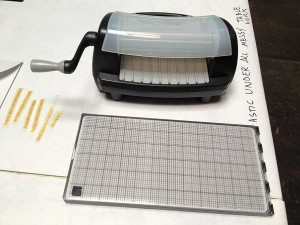Recently I was up at the Institute of Cultural Inquiry (of which I am a longtime Associate), where I discovered that the ICI has acquired one of the tabletop die-cutters that have become popular in the last few years. This particular model comes with an insert that turns the die-cutter into a small letterpress printer. As one can tell both from the machines themselves—usually plastic and often cast in ‘feminine’ colors like pink and aqua—and the blogs where one finds information about their use (Not Another Craft Blog, Paper Pile Kitten), they are associated almost entirely with those activities that are currently designated as crafting. That is to say, the unimportant, largely unpaid leisure activities of women; the modern descendants of Victorian flower-pressing and hair jewelry. As Lilly observed in an earlier post on DIY, crafting is often cast as the opposite of design, and it’s also often cast as the opposite of technology and skilled work generally (never mind the facts).
What I wanted to talk about here, though, is not so much the problematic social status of crafting itself, but two specific aspects of the circulation of these kinds of small machines. The first might be thought of as a variation on the network effect. Traditionally, letterpress printing and die-cutting have been highly skilled occupations, and their products—hand-printed wedding invitations, small-run artist’s books, high-end PR materials with elaborate cutouts—have largely been luxuries for the well-to-do. The limited market has, in turn, helped to keep the industry small and operating under an almost guildlike mentality. So what happens when thousands of these machines get into the hands of untrained or semi-skilled individuals? Quality of output will initially go down in many cases—at least until the process of education-by-internet takes off—but public appreciation of letterpress printing and die-cutting goes way, way up. Two niche trades rather suddenly become part of a much larger arsenal of broadly practiced design-and-making techniques such as papermaking, woodworking, photography. And as Julia Lupton pointed out in a dialogue with Lilly, you never know what can come of “having access to tools that will help you shape your outlook in dialogue with other people, in ways that might not be predicted.” As with other downsized or simplified technologies—small cameras, for example—it is easy to view these small machines primarily as technological downgrades. But when I think of all those people out there experimenting with their tabletop presses and diecutters, what I see is a field of cultural potentials.
The second aspect of these machines that strikes me is how clearly they reflect the strict partitioning of the larger internet conversations about ‘new’ technology. The sites most associated with geekery, like boingboing or slashdot (not to mention all those ad-supported geek blogger-reviewers), are quick to parse every tiny iteration of the iPhone operating system or the latest inkjet printers. Many of these changes are really minuscule in their practical effects on users and form part of a larger pattern of hyping anything in the computational sphere. DIY technologies get some mention, but almost exclusively in their male-centric forms (think robots and 3D printing of nerdish objects). The development of small, hand-cranked die-cutter/presses whose early adopters include a lot of scrapbookers? Not interested.
